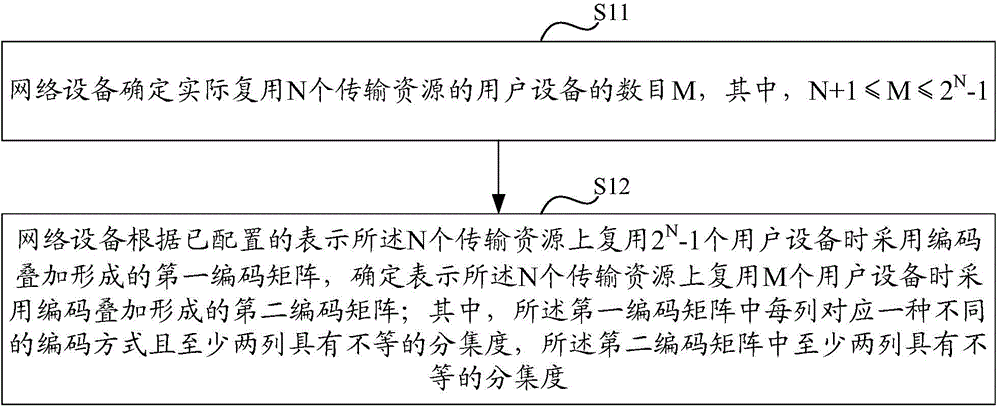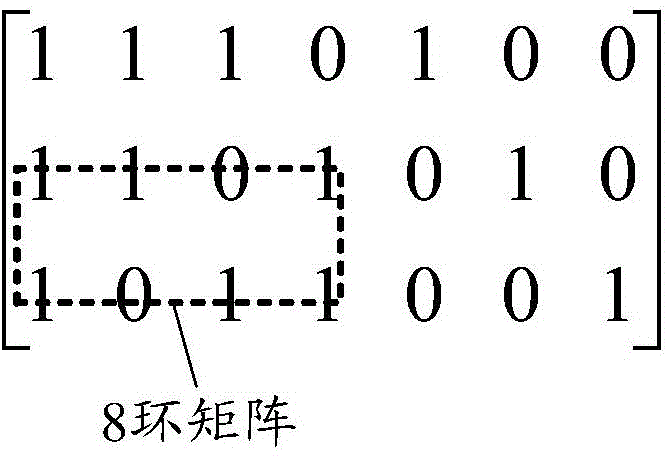Multi-user code superposition-based code matrix determining method and device
A coding matrix and user equipment technology, applied in the field of communication, can solve problems such as difficult multi-user detection performance improvement
- Summary
- Abstract
- Description
- Claims
- Application Information
AI Technical Summary
Problems solved by technology
Method used
Image
Examples
Embodiment 1
[0151] Embodiment 1. For N=2, the maximum number of users that can be supported by theoretical capacity enhancement is 3, which is only 1 more than the number of orthogonal multiplexing users 2. Therefore, the actual number of non-orthogonal multiplexing user equipments It is equal to the number of theoretical non-orthogonal multiplexing user equipments, and the second coding matrix determined by the network device is equal to the first coding matrix.
Embodiment 2
[0152] Embodiment 2. For N=3, the maximum number of users that can be supported by its theoretical capacity enhancement is 7, which is 4 more than the number of users of orthogonal multiplexing 3. Therefore, the actual number of non-orthogonal multiplexing users can be 4 or 5 or 6 or 7, depending on how much complexity the system can support. Correspondingly, the actual PDMA coding matrix can have various forms, such as and is equivalent to that corresponding to formula (6) In this case, the capacity multiplexing gains corresponding to different second encoding matrices are shown in Table 2.
[0153] M’
η(%)
4
133
5
167
[0154] 6
200
7
233
[0155] Table 2
[0156] (1) Assuming that N=3, the number of multi-users that the system can actually support is 6, then:
[0157] If the above method 31 is adopted, try to ensure that there is a reasonable degree of inconsistent diversity among the six user...
Embodiment 3
[0169] Embodiment 3. For N=4, the number of multi-user multiplexing corresponding to its theoretical capacity improvement is 15, which is 11 more than the number of users of orthogonal multiplexing 4. Therefore, the actual number of non-orthogonal multiplexing users can be 5 to 11, and the specific number will depend on the complexity that the system can support. Correspondingly, the actual PDMA coding matrix can have 11 forms, namely and It is equivalent to the first encoding matrix shown in formula (8). In this case, capacity multiplexing gains corresponding to different second encoding matrices are shown in Table 3.
[0170] M’
η(%)
5
125
6
150
7
175
8
200
9
225
10
250
11
275
12
300
13
325
14
350
15
375
[0171] table 3
[0172] Below to As an example, the method provided by the embodiment of the present invention is described,...
PUM
 Login to View More
Login to View More Abstract
Description
Claims
Application Information
 Login to View More
Login to View More - R&D
- Intellectual Property
- Life Sciences
- Materials
- Tech Scout
- Unparalleled Data Quality
- Higher Quality Content
- 60% Fewer Hallucinations
Browse by: Latest US Patents, China's latest patents, Technical Efficacy Thesaurus, Application Domain, Technology Topic, Popular Technical Reports.
© 2025 PatSnap. All rights reserved.Legal|Privacy policy|Modern Slavery Act Transparency Statement|Sitemap|About US| Contact US: help@patsnap.com



